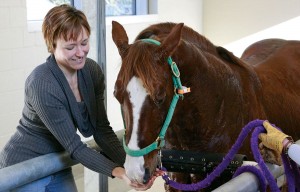 We had a question come in regarding strangles. This year, the American College of Veterinary Internal Medicine (ACVIM) came out with a consensus statement on this disease. I will go over the key items discussed and the bio-security measures they recommend. These recommendations apply to any outbreak of contagious disease, although each disease may have some minor changes.
We had a question come in regarding strangles. This year, the American College of Veterinary Internal Medicine (ACVIM) came out with a consensus statement on this disease. I will go over the key items discussed and the bio-security measures they recommend. These recommendations apply to any outbreak of contagious disease, although each disease may have some minor changes.
Strangles is a term used to describe a bacterial infection caused by the organism Streptococcus equi ssp equi. The common presentation is a respiratory disease with lymph node enlargement. Horses typically have a fever and severe nasal discharge. The bacteria starts to be shed in nasal secretions 2-3 days after the onset of fever and typically persists for 2-3 weeks. It is recommended that all recovered horses be treated as potentially infectious for six weeks after the resolution of purulent (pus) discharge. From 20-25 percent of horses recovering from the disease can become susceptible to a second attack of the disease. An average of 10 percent of horses will have a persistent infection in their guttural pouches, which are located in the throat area and can test positive from that area for months to years without showing outward clinical signs. These types of animals, healthy without showing signs, are thought to be more important in the spread of the disease as they are not recognized as sick.

OSU photo by Santiago Uceda
That seems like some scary information to take in. Luckily, most animals recover from the disease and are fine. The one thing you can do for your horse to prepare it for this disease is to vaccinate it. There are currently two different vaccines on the market in the USA for Strangles. One is a modified live vaccine that is squirted up the nose. The other is a killed vaccine that is given in the muscle like most others. They both have their pluses and minuses, but you can discuss with your veterinarian which one you want to use.
Well, we have learned some about the disease and the measure we can use in advance to protect our horses. Let’s now discuss what to do if you have an outbreak.
1) Quarantine! Separate those sick animals from the healthy ones. As new cases develop fevers, move them to the quarantine.
2) If possible, have a separate person care for the sick animals. If not, make those the last ones cared for and have the caretaker shower and change clothing before returning to the healthy animals.
3) Any areas exposed to the sick animals should be cleaned of any manure or other organic material with a foaming soap agent and not power-washed.
4) You can obtain a surface disinfectant like Roccal or Vetoquinol to disinfect surfaces, tools and tack
5) Pastures that have been exposed to sick horses should be left vacant for several weeks. The bacteria remains viable in water for 4-6 weeks but in feces or soil dies in 1-3 days.
Lastly, make sure to involve your veterinarian. They can identify and test for the disease. Some horses may require antibiotics to help them although most will resolve the infection on their own. In some states, the disease is reportable and the state veterinarian will need to be notified.
Hopefully, this answers some questions on Strangles and also on things you can do not only with this disease, but many others to minimize the transmission to your horse(s).
–Dan
 We had a question come in regarding strangles. This year, the American College of Veterinary Internal Medicine (ACVIM) came out with a consensus statement on this disease. I will go over the key items discussed and the bio-security measures they recommend. These recommendations apply to any outbreak of contagious disease, although each disease may have some minor changes.
We had a question come in regarding strangles. This year, the American College of Veterinary Internal Medicine (ACVIM) came out with a consensus statement on this disease. I will go over the key items discussed and the bio-security measures they recommend. These recommendations apply to any outbreak of contagious disease, although each disease may have some minor changes.
Leave a Comment
All fields must be filled in to leave a message.